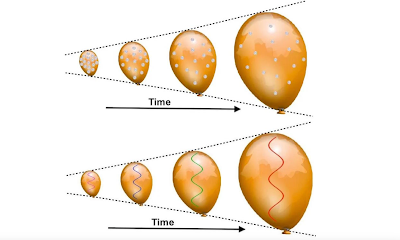"Researchers from the University of Texas at Arlington analyzed planets orbiting F-type stars for their habitability potential. They identified 18 systems of interest, including HD 111998, a Jupiter-like planet located in the habitable zone. Credit: SciTechDaily.com" (ScitechDaily, In Search of Habitable Planets: New Study Points to F-Type Systems for Life)
The F-type stars are quite common things in the universe. Those stars are quite similar to the sun. But they are a little bit hotter. The nickname for those stars is "blue suns". Theoretically, those stars can support life on habitable planets. But could that lifeform advance to an intelligent level? Or could it even create civilizations? Honestly, we don't know. There are two facts that we often forget.
1) An intelligent lifeform is not the same thing as a lifeform.
2) Another thing is that the lifeform on another solar system is adapted to that planet and that solar system.
"A simple chart for classifying the main star types using Harvard classification" (Wikipedia, Stellar classification) The F-type stars have stronger hydrogen emission lines than the G-type stars. That can cause stronger resonance in hydrogen atoms than G-type stars. Hydrogen's strong resonance or oscillation can make it harder to form water molecules than around the G-type stars.
When we think about those two things we face an interesting fact from our own planet. Fish has as long an evolution as humans. It lives on the same planet as humans. But most of the fishes cannot live on dry ground. And human cannot live under the sea without life support system. There are lung fishes that can rise to dry land.
But most of those fishes are trapped in their wet element. And that element is hostile to humans. As well as dry lands are hostile to fish. So we can say that fish is alien to us.
But let's go back to the F-type stars and their planets. The F-type stars or late F-stars are only a little bit hotter than the sun. The other thing is that theoretically, all stellar types can support some kind of life form. There are so many variables that the planet must pass. One of them is that. If the habitable is too far away from the star, a large- or massive planet pulls too many cosmic wanderers to it.
And that can cause a cosmic impact that ended the existence of Formahaut B. The thing is that the F-type stars are more common than the G-type stars. And maybe, we should involve some other stars than just our own G-type star in those calculations.
Callisto
"Model of Callisto's internal structure showing a surface ice layer, a possible liquid water layer, and an ice–rock interior" (Wikipedia, Callisto (moon))
Europa
"Model of Europa's possible interior structure, with a thin ice crust and a subsurface ocean atop a rocky mantle and metallic core" (Wikipedia, Europa (Moon))
Ganymede
"Artist's cut-away representation of the internal structure of Ganymede. Layers drawn to scale." (Wikipedia, Ganymede(Moon))
Io
"Model of the possible interior composition of Io with various features labelled." (Wikipedia, Io (moon))
Searching life from our solar system.
All other Galilean moons than Io have subsurface oceans. That causes interesting thoughts about the existence of life on some other planet or moon in our own solar system.
The fact is that. The cosmic life can be quite common. But most of that is more primitive than eucaryote bacteria. Another thing is that the bacteria in the form we know will not be able to send radio transmissions. Another thing is that the observations about things like fungi and their ability to learn things make it important to re-estimate intelligence.
Learning and making decisions don't require neurons. But how intelligent that kind of creature can be? The fact is that it's quite hard to imagine walking mushrooms or fungi that are like humans. Another fact is that nobody knows where evolution goes in another solar system. All alien creatures that we see in more or less scientific films are fictional or hypothetical. Nobody ever visited another solar system. Or even on our closest neighbor planets, there are atmospheres. Most of our solar system is still unknown to us.
The first serious attempt to find extraterrestrial lifeforms is the Europa Clipper probe that travels to Jupiter's icy moons. Flight time to that moon is 5,5 years. The planned time to arrive at Jupiter orbiter is April 11, 2030.
There that probe tries to find out. If there are some kind of alien lifeforms under the Europa moon's icy shell. If there are no bacteria or alien bases Europa would be a good place to test what happens if that moon is polluted with bacteria. But those tests require that there are no lifeforms under the icy shell of that distant moon.
There are also oceans under the Ganymede and Callisto surfaces. And that thing makes those moons very interesting for astrobiologists. Saturn's Enceladus moon also has an ocean under its surface. That moon is quite young and that means there could be organic material from somewhere else. Or, why not lifeforms? But confirming the existence or nonexistence of lifeforms requires a probe. And that is more expensive and takes lots more time than Europa Clipper.
The flight time to another interesting moon, Saturn's Enceladus takes almost 7 years. Cassini-Huygens probe traveled to Saturn in 6 years 261 days.
The long flight time means that those missions require more effective rockets like nuclear thermal rockets. There is one interesting model for manned missions to outer planets. The spacecraft uses gravity sling to travel to those gas giants. The idea is that mission control sends the spacecraft empty to the mission. When the spacecraft makes the last flyby during gravity acceleration and its speed is high enough the crew will dock to that craft. That minimizes the zero gravity time. But the flight time to those gas giants is still too long.
https://scitechdaily.com/in-search-of-habitable-planets-new-study-points-to-f-type-systems-for-life/
https://scitechdaily.com/no-brains-no-problem-the-surprising-intelligence-of-fungi/
https://en.wikipedia.org/wiki/Callisto_(moon)
https://en.wikipedia.org/wiki/Enceladus
https://en.wikipedia.org/wiki/Europa_(moon)
https://en.wikipedia.org/wiki/Europa_Clipper
https://en.wikipedia.org/wiki/Ganymede_(moon)
https://en.wikipedia.org/wiki/Io_(moon)















































